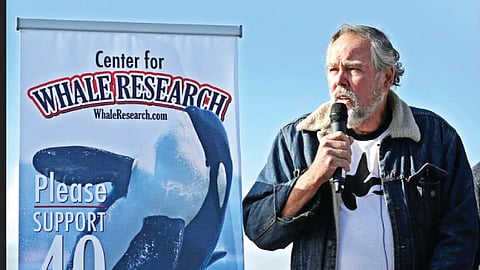

Clay Risen
Ken Balcomb, whose meticulous decades-long effort to track a population of killer whales in the Pacific Northwest did much to transform the marine mammals’ image from soulless predators to compassionate creatures worth protecting, died on Dec. 15 at a ranch house on the Elwha River, west of Seattle. He was 82. His son, Kelley Balcomb-Bartok, said the cause was prostate cancer. The house where Balcomb died is owned by the Center for Whale Research, which he founded in 1984 and which he built into one of the world’s leading organizations for research on killer whales, also known as orcas.
When the center was founded, orcas were still poorly understood, feared by fishermen, who saw them as competition, and gawked at by tourists, who saw them performing in amusement parks across the country. During the 1960s and ’70s, hunters rounded them up like cattle for sale to the parks; they used stun bombs and nets to capture dozens of them, killing at least 13 in the process.
People also thought that orcas were numerous, living far out in the Pacific and only occasionally coming close to land, part of the sea’s supposedly limitless bounty. Balcomb’s research, including an annual survey begun in 1976, showed otherwise: The orcas found in the waters off Seattle’s shoreline were mostly neighbors, not transients — and there were far fewer of them than suspected.
He focused his work on a group of whales in and around the Puget Sound. Called the Southern Resident orcas, they numbered about 70 when he began and had grown to about 120 by the 1990s. It is said that scientists today know more about this particular population of marine mammals than any other in the world, thanks almost entirely to Balcomb.
For about seven months every year, he and a small team of researchers, along with a larger group of volunteers, spent every day on the sound and its surrounding waters cataloguing orcas. They took photographs to document newborns, and they noted which ones were absent and perhaps dead. Balcomb knew the whales so well that he could call out an animal’s catalogue number — he wasn’t much for nicknames — just by looking at the distinctive white patch behind its dorsal fin. By the early 2000s he had known most of his subjects from birth, and they seemed to know him. They would swim up to his boat to display their young, or poke alongside playfully as he returned to shore.
He rigged his home, on the northwest shore of San Juan Island, with a stereo linked to hydrophones out in the water. When an orca passed, he could often identify its whale song. Carl Safina, an author and ecologist who teaches at Stony Brook University on Long Island and knew Balcomb well, said in a phone interview, “I’m a musician, and I have a decent ear, and I could not understand how he was disentangling the squeaks and squeals.”
Balcomb was a cross between an old-school naturalist and a modern environmentalist, though he looked every bit the weather-beaten fisherman: stout, with a thick white beard and facial creases like canyons.
He never made a lot of money, and he lived mostly off donations and grants. But he didn’t need much, just enough to keep his boat in shape and his gear up to date. He could be ornery if he didn’t get out on the water often enough.
Clay Risen is a journalist with NYT©2023
The New York Times
Visit news.dtnext.in to explore our interactive epaper!
Download the DT Next app for more exciting features!
Click here for iOS
Click here for Android